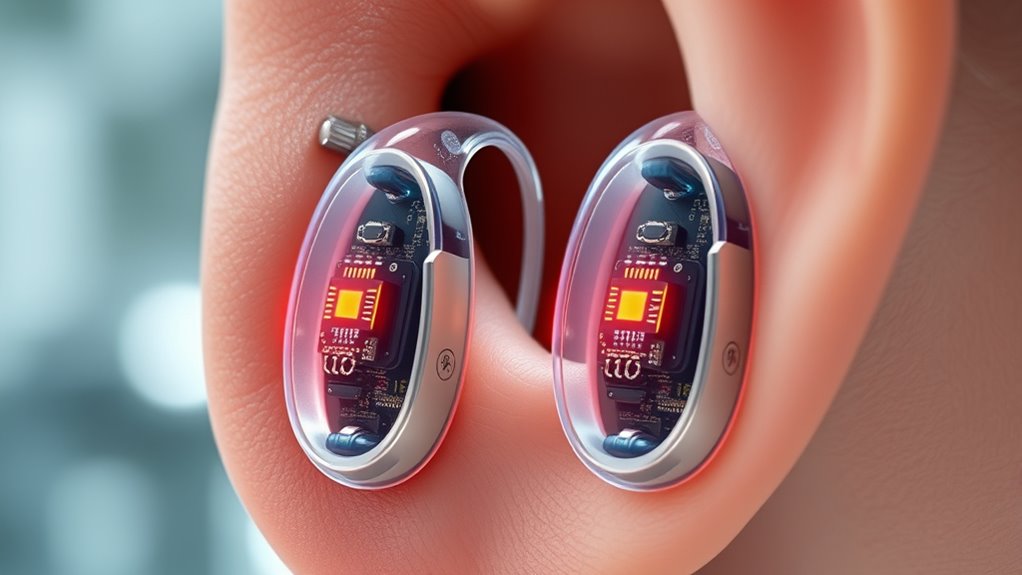In 2025, embedded AI chips in hearing aids are making a big difference by offering smarter sound processing, personalized settings, and real-time translation. These tiny, efficient chips improve clarity, suppress background noise, and adapt to your environment instantly. They also support longer battery life and smaller, more discreet designs. If you want to discover how these innovations can enhance your hearing experience further, keep exploring the latest advancements.
Key Takeaways
- AI chips enable real-time environment analysis, enhancing noise reduction and speech clarity in diverse listening settings.
- Integration of AI chips supports personalized sound profiles and automatic adjustments based on user preferences.
- Advances include improved processing speed, longer battery life, and seamless device connectivity for enhanced user experience.
- AI chips facilitate instant language translation and contextual awareness, promoting better multilingual communication.
- Privacy and security measures are prioritized to protect sensitive user data amid increasing AI capabilities.
The Evolution of AI Integration in Hearing Devices
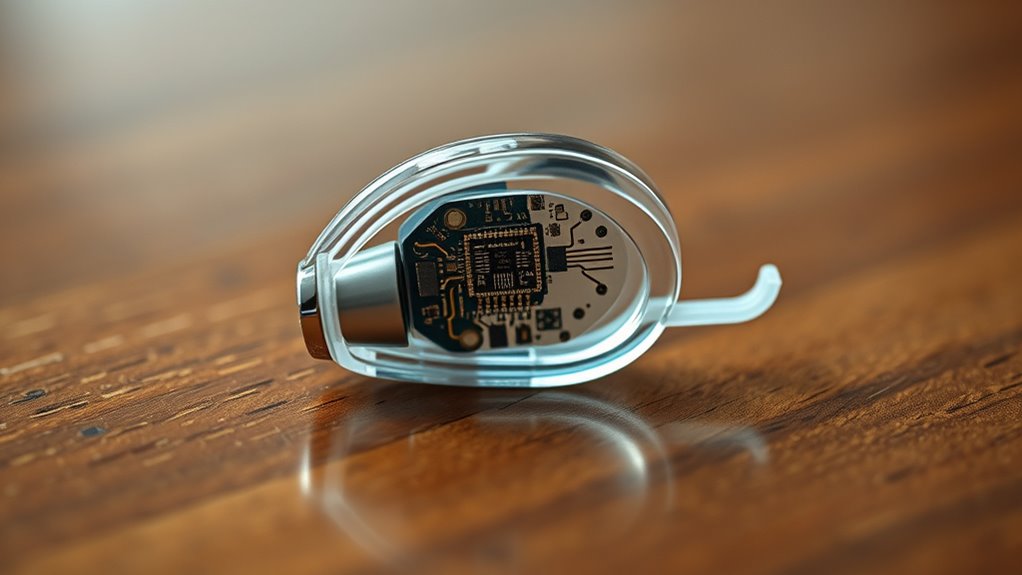
The integration of AI into hearing devices has progressed rapidly over the past decade, transforming how users experience sound. Today, AI-powered hearing aids offer improved battery longevity, allowing you to enjoy longer periods of use without frequent recharging. This advancement results from smarter power management and efficient chip design, making devices more reliable and convenient. Additionally, AI enables extensive user customization, tailoring sound profiles to your specific hearing needs and environments. You can adjust settings effortlessly or let the AI learn your preferences over time, enhancing comfort and clarity. These innovations make hearing aids more adaptive and user-friendly, ensuring you get a personalized listening experience without sacrificing device performance or battery life. Moreover, the incorporation of embedded AI chips enhances processing speed and accuracy, further improving overall sound quality and user satisfaction.
How Embedded AI Chips Enhance Sound Clarity and Quality

Embedded AI chips improve sound clarity by reducing background noise and focusing on what matters most. They adapt to your environment with real-time sound processing, making voices clearer and more natural. This technology also personalizes your listening experience, ensuring ideal sound quality in any setting. Additionally, advancements in offensive security measures help protect the devices from potential cyber threats, ensuring user privacy and data security.
Advanced Noise Reduction
How do embedded AI chips dramatically improve noise reduction in modern hearing aids? They leverage AI algorithm optimization to distinguish speech from background noise more accurately. These advanced algorithms analyze sound patterns in real time, filtering out unwanted sounds with precision. Hardware integration techniques ensure that AI processing occurs seamlessly within the compact device, reducing latency and power consumption. By tightly integrating sensors, microphones, and processors, embedded AI chips can adapt quickly to changing environments, enhancing sound clarity and comfort. This synergy allows for more effective noise suppression without sacrificing speech intelligibility. Additionally, Pimple Patch technology can be incorporated into hearing aid design to further improve skin comfort and device wearability. Overall, the combination of AI algorithm optimization and innovative hardware integration transforms hearing aids into smarter, more responsive devices, providing users with a clearer and more natural listening experience in noisy settings.
Adaptive Sound Processing
As embedded AI chips continuously analyze incoming sounds, they dynamically adjust processing to enhance clarity and overall sound quality. This adaptive sound processing sharpens your auditory perception by filtering noise and emphasizing speech. It also improves device connectivity, allowing your hearing aids to seamlessly sync with other devices for real-time sound adjustments. With this technology, you experience clearer conversations even in complex environments. Active listening is further enhanced as the AI anticipates and responds to your listening needs, creating a more personalized hearing experience. Key benefits include:
- Automatic noise suppression tailored to surroundings
- Real-time focus on speech sources
- Enhanced sound differentiation
- Improved responsiveness to changing environments
These features ensure your hearing aids adapt instantly, delivering a natural listening experience. By optimizing sound quality on the fly, embedded AI chips make every conversation clearer and more comfortable, regardless of background noise or device connections.
Personalized Listening Experience
Thanks to AI-powered chips, your hearing aids can tailor sound processing specifically to your unique hearing preferences and environments. This creates a truly personalized listening experience, improving sound clarity and quality. Embedded AI analyzes the environment and adjusts settings in real-time, focusing on speech while reducing background noise. You can customize these settings to match your preferences, ensuring comfort and ideal hearing. Additionally, manufacturers implement secure protocols to protect your information from potential privacy concerns that may arise with user data collection. Here’s a quick look at how personalization works:
| Environment Type | Sound Enhancement Effect |
|---|---|
| Quiet Room | Clear speech, minimal noise |
| Crowded Place | Background noise reduction |
| Outdoor | Wind noise filtering |
This technology empowers you to hear better while maintaining control over your sound profile.
Adaptive Noise Cancellation and Environmental Awareness
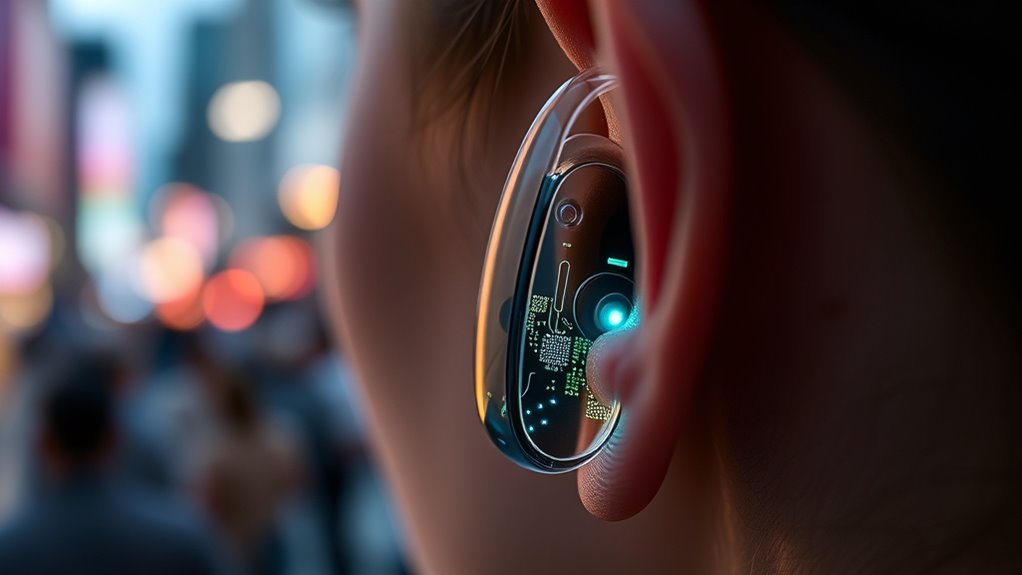
Embedded AI chips in hearing aids enable real-time adaptive noise cancellation, allowing the devices to distinguish between speech and background sounds effectively. They dynamically adjust to your environment, enhancing clarity and comfort. This technology improves contextual awareness, so your hearing aids can adapt seamlessly whether you’re in a crowded cafe or a quiet room. Additionally, AI enables emotional recognition, helping the device gauge your mood and adjust sound profiles accordingly. You’ll experience clearer conversations and a more natural listening experience. Ongoing research into AI safety emphasizes the importance of developing reliable and secure AI systems to prevent vulnerabilities and ensure trustworthy operation.
Personalized User Experiences Driven by Artificial Intelligence

Building on the advanced environmental adaptability of AI chips, personalized user experiences take the technology a step further by tailoring sound profiles to your individual preferences and needs. With AI-driven adjustments, your hearing aid learns from your daily environments, optimizing sound clarity and comfort automatically. Vetted product reviews can help guide your choices in selecting the most suitable device. However, as these devices become more personalized, AI ethics and user privacy become vital considerations. Manufacturers must guarantee your data is securely stored and used responsibly, respecting your privacy rights. Clear communication about data collection and consent is essential. By prioritizing user privacy and adhering to ethical standards, these personalized features enhance your experience without compromising trust. Ultimately, AI-powered personalization makes hearing aids more intuitive, comfortable, and aligned with your unique hearing requirements.
Real-Time Language Translation and Communication Features
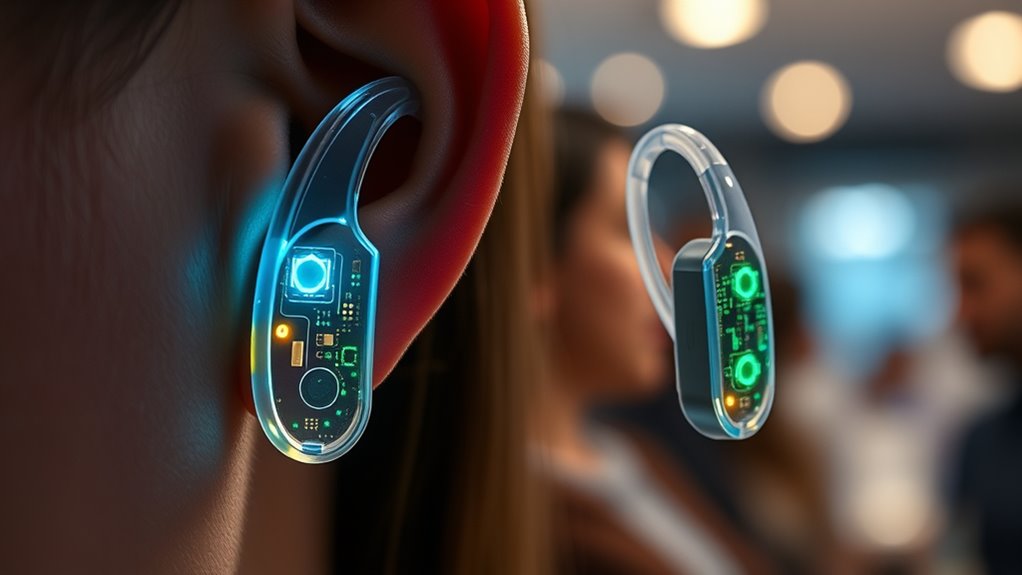
As AI chips in hearing aids become more advanced, they now enable real-time language translation, bridging communication gaps instantly. You can engage in multilingual conversations effortlessly, breaking down language barriers on the spot. These features make it easier to connect with people from different cultures without missing a beat. With instant translation, your hearing aid acts as a personal interpreter, providing seamless communication in various settings. You’ll find these capabilities especially useful during travel, meetings, or social gatherings. Key features include:
- Real-time translation of multiple languages
- Clear, natural-sounding speech output
- Support for conversational, context-aware translation
- Easy switching between languages for smooth communication
This advancement enhances your ability to participate fully in diverse conversations, making every interaction more inclusive. AI security technologies ensure that sensitive data and personal information are protected during these sophisticated exchanges.
Power Efficiency and Miniaturization of AI Components

Advancements in power efficiency and miniaturization are transforming AI components in hearing aids, allowing these devices to perform complex tasks without sacrificing size or battery life. Modern AI chips consume less power, which directly improves battery longevity, so you can enjoy longer use between charges. Miniaturization also enables the integration of powerful AI within smaller form factors, making hearing aids more discreet and comfortable. Effective thermal management is essential, as it prevents overheating, ensuring consistent performance and user safety. Engineers focus on optimizing chip designs to reduce heat output while maintaining processing capabilities. Additionally, innovations in preppy dog names are inspiring new ways to personalize devices, offering options that reflect individual style and personality. As a result, hearing aids become more efficient, longer-lasting, and unobtrusive, enhancing your overall experience without compromising on performance or comfort.
Regulatory and Ethical Considerations for AI-Enabled Hearing Aids

The integration of AI chips into hearing aids brings not only technological benefits but also important regulatory and ethical considerations. Privacy concerns are paramount, as AI collects sensitive data about your hearing patterns and environment. You must guarantee this data is protected from misuse or unauthorized access. Regulatory challenges include establishing standards for safety, effectiveness, and data security, which can delay approvals and market entry. Ethical issues revolve around informed consent, data ownership, and potential bias in AI algorithms that might affect personalized hearing care. Additionally, implementing data encryption and secure data storage practices can help mitigate privacy risks and build user trust.
Future Outlook: Emerging Trends and Innovations for 2025 and Beyond
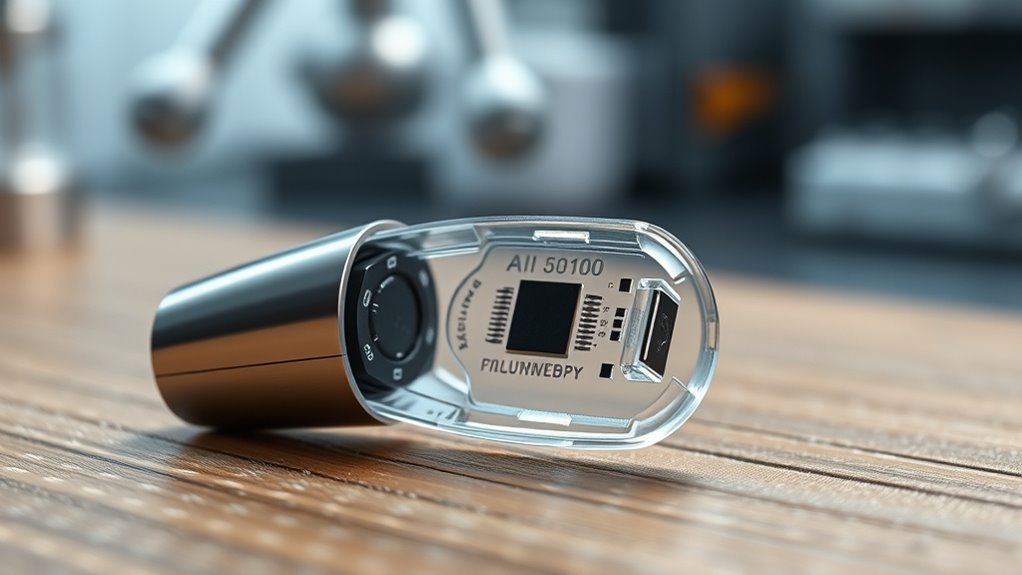
Looking ahead to 2025 and beyond, emerging trends in embedded AI chips promise to revolutionize hearing aids by making them smarter, more personalized, and seamlessly integrated with other devices. As technology advances, you’ll see innovations like more intuitive sound processing and adaptive features tailored to your environment. However, privacy concerns will remain a key consideration, with manufacturers needing to safeguard your data against unauthorized access. Market adoption will accelerate as these enhancements demonstrate clear benefits, encouraging more users to upgrade. Expect to see increased collaboration between device makers and tech firms to develop secure, user-friendly solutions. Overall, these trends will drive broader acceptance and help you experience more natural, connected hearing experiences in everyday life.
Frequently Asked Questions
How Secure Is Personal Data Collected by Ai-Enabled Hearing Aids?
You’re likely wondering how secure your personal data is with AI-enabled hearing aids. These devices prioritize data privacy and implement strong security protocols to protect your information. Manufacturers use encryption and regular updates to prevent unauthorized access. While no system is completely foolproof, your hearing aid’s security measures are designed to keep your data safe, giving you peace of mind about your personal information’s privacy.
Can AI Hearing AIds Adapt to Sudden Environmental Changes Automatically?
You’ll find that AI hearing aids can automatically adapt to sudden environmental changes thanks to advanced features like adaptive noise reduction and enhanced environmental awareness. These aids constantly monitor your surroundings, adjusting settings in real-time to improve clarity and comfort. Their ability to seamlessly respond to unexpected sounds or shifts guarantees you stay aware and engaged without needing manual adjustments, making your auditory experience more natural and effortless.
What Is the Expected Lifespan of Embedded AI Chips in Hearing Devices?
Imagine your hearing aid’s AI chip suddenly failing just when you need it most. The lifespan depends on chip durability and regular software updates, which can extend its life. Typically, these chips last around 5 to 7 years, but advancements mean you might enjoy even longer performance. Stay vigilant with updates, and you’ll likely maximize your device’s longevity, keeping you connected and confident for years to come.
Are Ai-Powered Hearing Aids Compatible With Other Smart Health Devices?
You’ll find that AI-powered hearing aids are increasingly compatible with other smart health devices, thanks to advancements in device interoperability and technology integration. These devices often connect via Bluetooth or Wi-Fi, allowing seamless data sharing and synchronized health monitoring. As a result, you can enjoy more personalized, holistic health management, making it easier to track your wellness trends and receive tailored alerts across your ecosystem of smart devices.
How Will AI Advancements Impact the Affordability of Hearing AIds?
AI advancements will considerably impact the affordability of hearing aids by driving cost reduction through more efficient manufacturing and technology integration. As AI makes devices smarter and more accessible, market expansion will follow, increasing competition and lowering prices. You’ll find more affordable options, making advanced hearing aids available to a broader population. These innovations guarantee you benefit from better technology without the high costs traditionally associated with premium hearing aids.
Conclusion
By 2025, embedded AI chips will revolutionize hearing aids, offering unprecedented sound clarity and personalized experiences. Imagine a user in a busy café, where the device intelligently filters noise and translates conversations in real time. As technology advances, you’ll benefit from smarter, more efficient hearing solutions that adapt seamlessly to your environment. This innovation not only enhances your hearing but also empowers you to connect more confidently and naturally in any setting.

